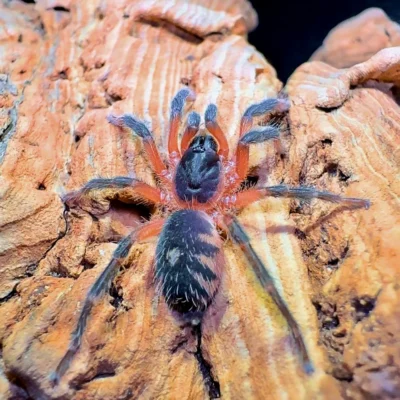Buy subadult tarantula online.
Subadult tarantulas in the Theraphosidae family are at a pivotal stage—past the fragile sling phase but not yet sexually mature. They’re ideal for collectors, breeders, and educators who want visible growth, stable behavior, and species-specific traits without the unpredictability of juveniles. Here’s a full breakdown tailored to your level:
🕷️ Subadult Tarantula Profile (Theraphosidae)
| Attribute | Details |
|---|---|
| Instar Stage | Typically 5th–8th instar (species-dependent) |
| Size Range | ~5–12 cm (2–5 inches) leg span |
| Sexual Maturity | Not yet reached—usually 1–3 molts away |
| Behavior | More stable, less skittish, feeding regularly |
| Molting Frequency | Slows down compared to juveniles; ~every 3–6 months |
Subadults begin to show adult coloration, body proportions, and temperament, making them ideal for display and training setups.
🧬 Notable Theraphosidae Genera at Subadult Stage
- Theraphosa spp. (e.g., T. stirmi, T. blondi)
- Massive terrestrial giants from South America
- Subadults already reach 6–7 inches
- Require high humidity and a deep substrate
- Grammostola spp. (e.g., G. pulchripes, G. rosea)
- Docile, hardy, and slow-growing
- Subadults show full coloration but remain manageable in size
- Ideal for beginner keepers and educational setups
- Pamphobeteus spp. (e.g., P. solaris, P. antinous)
- Fast-growing, bold, and vividly colored
- Subadults display iridescent hues and a strong feeding response
- Popular in the exotic morph trade
- Aphonopelma spp. (e.g., A. johnnycashi)
- Native to North America; slow-growing and long-lived
- Subadults are hardy and ideal for dry setups
- Buy subadult tarantula online
🏡 Enclosure Setup
- Tank Size: 5–10 gallons per subadult
- Substrate: 3–5 inches of coco fiber, peat moss, or topsoil
- Temps: 72–82°F (22–28°C)
- Humidity: 60–80%, species-dependent
- Hides: Cork bark, half logs, burrowable zones
- Lighting: Ambient only—avoid direct light
Subadults are burrowers and ambush predators, so naturalistic setups improve behavior and reduce stress.
🍽️ Diet & Feeding
- Feeding Frequency: Every 5–7 days
- Prey Items:
- Adult crickets, dubia roaches, and mealworms
- Prey size should match body length
- Feeding Tips:
- Remove uneaten prey within 24 hours
- Mist lightly to aid hydration
Subadults show a strong feeding response and begin developing hunting routines.
🧠 Behavior & Temperament
- Nocturnal: Most active at night
- Defensive or docile: Depends on genus
- Handling: Not recommended—use a soft brush or a catch cup
- Molting: Watch for fasting, lethargy, and webbing before molt
They’re ideal for observation, photography, and behavioral studies.
⚠️ Legal & Ethical Notes
- Always source captive-bred subadults with documentation
- Avoid wild-caught specimens—many Theraphosidae are CITES-listed
- Never release into the wild—can disrupt native ecosystems






Reviews
Clear filtersThere are no reviews yet.